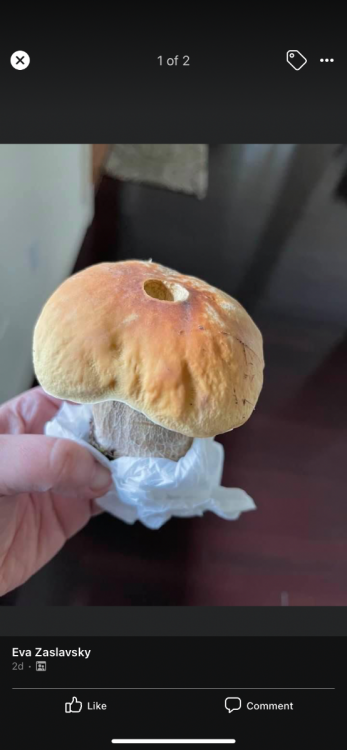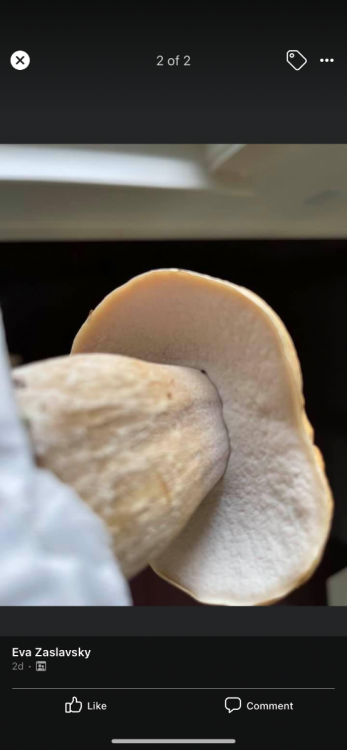

Jeff Falcone
Members-
Posts
263 -
Joined
-
Last visited
Everything posted by Jeff Falcone
-
one of the blushing Amanita. I'm not sure what we're calling them these days. Maybe something like amerirubescens group
-
not anymore. Those are puff balls. Lycoperdon perlatum or similar. They are edible when they are pure white inside, but once spores start to form they will make you sick. Once they turn brown on the outside they are well sporulated
-
that mushroom is not a polypore. It quite clearly has gills
-
How many mushrooms are pictured. Looks like three? Bottom 2 are Amanita. Top one maybe a Russula, but I'm not sure. If you make one post per mushroom you will get better answers. It's kind of confusing which pictures go together
-

Found in yard near spruce trees
Jeff Falcone replied to Kevin Hoover's topic in Identifying Mushrooms
Thanks Dave! Plausible hypothesis for sure -
I was thinking that the small amounts of latex were due to the mushrooms being very dry, but you're definitely right that the latex would be leaving brown stains. Should have caught that. Definitely not L. corrigus
-

Found in yard near spruce trees
Jeff Falcone replied to Kevin Hoover's topic in Identifying Mushrooms
I was thinking it looks like Leucoagaricus leucothites, but I can’t get past the dark edges of the gills. There also looks like dark colored dust on the stipe, that I was attributing to spores, otherwise I would have dismissed the discoloration of the gills more easily. What do you think is going on with the black/brown on the gill edges and on the stipe? Mold or something? -
Possibly L. corrigus It would be a lighter than usual color, but otherwise it matches well including the faint fishy odor
-

Found in yard near spruce trees
Jeff Falcone replied to Kevin Hoover's topic in Identifying Mushrooms
Any notable smell? I'm thinking maybe one of the agaricus species that don't have a pink gill phase - A. augustus for example. It doesn't quite fit A. augustus because the cap isn't scaly I'm very interested. Those dark spores on white detached gills are an unusual sight for me. The only mushrooms I can think of with dark spores on sometimes white gills are agaricus. Can't wait to see where this one goes. -
You’re correct. Definitely not G. frondosa. I just saw these identified recently, but I’m drawing a blank. It will come back to me
-
These are a cortinarius species. Definitely not G. marginita. Cortinarius is an extremely large genus that can be quite difficult to identify to the species. Some species of cortinarius are toxic.
-
This mushroom was identified on another forum as B. chippewaensis and I immediately thought of this thread. It was identified by the same person who told me about the pink staining. He seems to be quite familiar with this species and I’ve seen enough of his identification to trust him. Looks very similar to me.
-

Need help identifying these
Jeff Falcone replied to Nelsonastronauti's topic in Identifying Mushrooms
Very cooI! I was having trouble finding that information -

Need help identifying these
Jeff Falcone replied to Nelsonastronauti's topic in Identifying Mushrooms
Does P. ovoideocystidiata present with rhizomorphs on the base of the stem? I'm reading that this is a fairly unique characteristic -

Need help identifying these
Jeff Falcone replied to Nelsonastronauti's topic in Identifying Mushrooms
Where are you located? These look to me Like Psilocybe azetecorum. If you are in an area that the occur, I'd say it fits. This is a low confidence proposal because the habitat isn't exactly correct. Any conifers around? -
I've seen someone point to similar staining on another forum as indication that the species was chippewaenis. I've also seen a post titled "the many looks of B. chippewaenis". There seems to be tons of variation in the cap and stem coloration.
-
Some days it feels like every group is still being sorted out in North America. It's tempting to write the word "group" after most id's
-
I am super curious about this lotion/compress that you intend to prepare. I've never heard of such a thing.
-
Could this be B. chippewaensis? I think that would explain the staining beneath the cuticle
-
Yes that is Grofola frondosa. Best way to cook is hard to say. They are a versatile mushroom. I've used them in dishes ranging from soup to pie and anything in between. Really any dish that prominently features store bought mushrooms can have G. frondosa substituted with superior results
-
I'd feel exactly the same.
-
My print was even lighter brown than yours and had some white sections. I know mushrooms don’t have multiple spore colors, so the white parts must be closer to the true spore color, but I was still too nervous
-
Looks like Leccinum scabrum to me. A very similar looking specimen was the first wild mushroom I foraged.
-
For most boletes, the color of the pores is essential for identification. I can't tell what color the pore are from your photo


